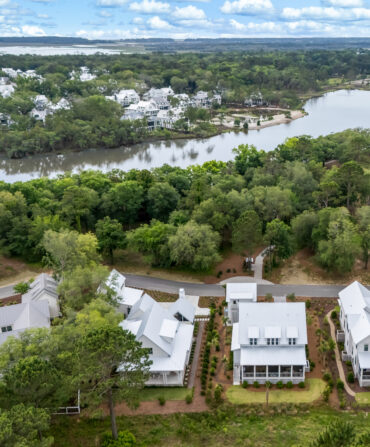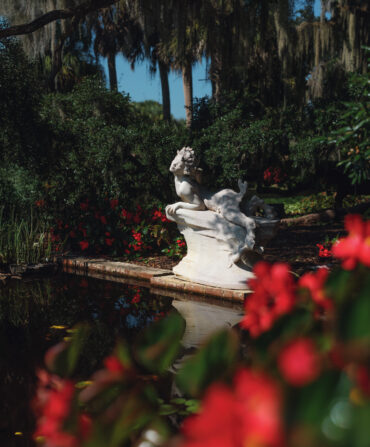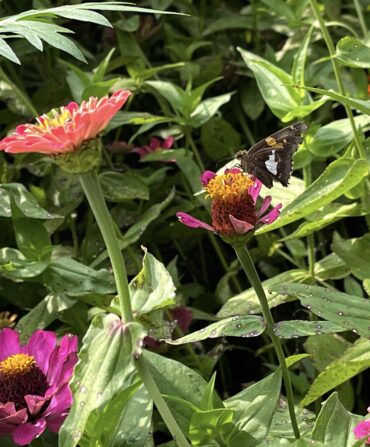Most artists don’t count waders and watercraft among their essential supplies. But then, Becky Davis doesn’t work like most artists. During solo sunrise and early evening forays into the Santee Cooper Lake System’s remote and tangled woodlands, the South Carolina native plunges into aprons of growth around ruddy creeks and coves, pulling a plant-filled canoe. It’s the only way, she says, to locate extraordinary stuff. That might be lotus and fragrant lily, or goat’s rue and possumhaw, as well as a variety of grasses and reeds that thrive in the rarefied milieu. Back in her Summerton studio, she dries and presses that bounty into botanical artwork that has become a favorite among designers and retailers from Southampton to California.
“I’m simply a gatherer who loves doing unusual things with flowers,” Davis says of her straight-to-the-source approach. “So what if I walk in the water to get that perfect specimen and my canoe is my basket?”

Photo: Terry Manier
The artist mounts a royal fern that has been pressed and dried.
That’s not to say she’s oblivious to the dangers of the job. On one outing, she startled a trio of sunbathing alligators, which in turn nearly capsized her boat, a memory she recalls with a shudder. But Davis isn’t deterred that easily. “You can’t be intimidated by circumstances when you’re searching for something that is unattainable any other way,” she says. “How else would I reach those wonderful plants?”
Growing up in the rural South, near Lake Marion, primed Davis for her future craft and contributed to her staggering knowledge of botany. “From the time I was a tiny girl, I was exposed to a heavenly array of seasonal greenery,” she says. “In our house the prevailing philosophy was that nothing—not even joe-pye weed, sweetgrass, or globe thistle—was too humble to use for decoration.”
Davis became what she calls a “true gatherer” almost twenty years ago when she co-owned a small waterfront restaurant on Lake Marion’s Potato Creek. With little money for design extras, she began foraging for decorating material. Early gathering trips resulted in dramatic arrangements of tall cattails, hat-shaped lotus leaves, water lilies, Queen Anne’s lace, cherry blossoms, and camellias that presided over one corner of the hundred-year-old bar and filled small green vases on every table. “These were not anything any florist could duplicate,” Davis says, “and I never knew what I was going to find, so the arrangements were always different and varied from season to season.” She hung that same flora, pressed flat and framed, on the walls in place of paintings—a resourceful bit of design magic that blossomed into a new career.
“Her pieces can transition everywhere,” says Sandra Graham, an interior designer based in Alexandria, Virginia. “I have installed them in a house in Maine, a money management firm in Pennsylvania, a beach home in North Carolina, and several homes throughout the Washington, D.C., area…with plants that are indigenous to every environment.”

Photo: Terry Manier
Still Life
Decorators and retailers often arrange Davis’s pressed botanicals in clusters for maximum impact.
Often hung in multiples for greater effect, the vivid or charmingly faded pieces showcase a range of organic materials, from palmetto, Chinese parasol, and tobacco to spiky grasses, water lilies, hydrangeas, and the delicate sea oats she gets from a legal source. (While they’re not technically endangered, it’s illegal to pick wild sea oats in Georgia and Florida.) Each botanical is encased on-site in Summerton by master framer Wade Edwards, then finished with Davis’s personal herbarium stamp and meticulous calligraphy that identifies both common and Latin names of the plant material.
In addition to waterborne flora, Davis seeks out flowers and plants that grow along highways, on ditch banks, and in treetops. With permission from local farmers, she picks millet in fields and roses from hedgerows, and combs nearby oak flats for jack-in-the-pulpits, wild fairy lilies, and violets. And she is not above stopping by someone’s yard to purchase particularly enticing specimens like bright zinnias. “The lovely thing about gathering is that it’s about roaming anywhere,” Davis says. “Away from the water, you pause on a country road and see ruins tumbling with wild poppies that someone planted long ago. Or strangers lead you to wonderful places. The experience translates into what you create.”
>For more information, go to bdbotanicals.com








